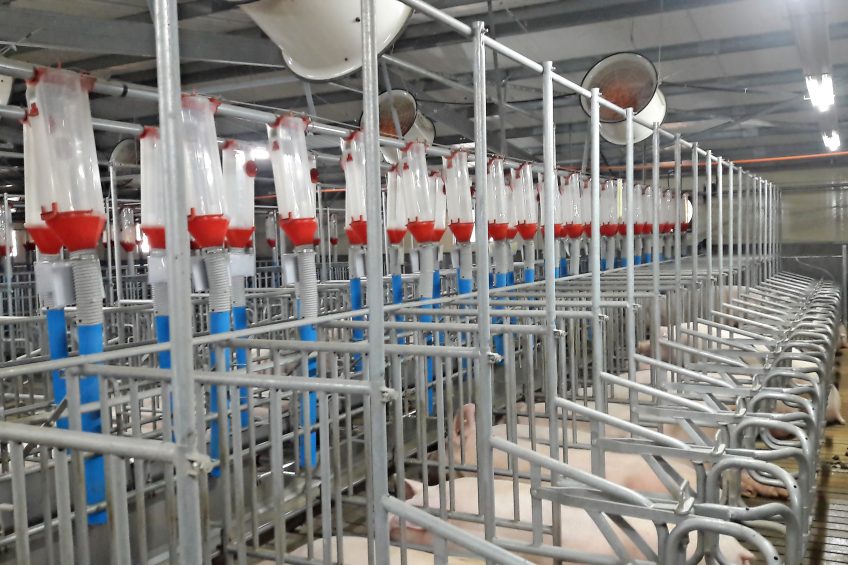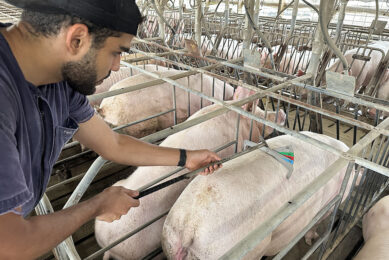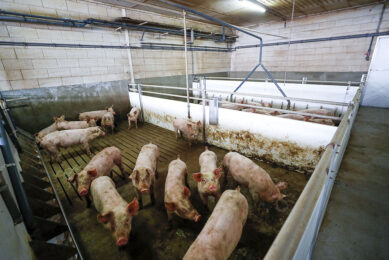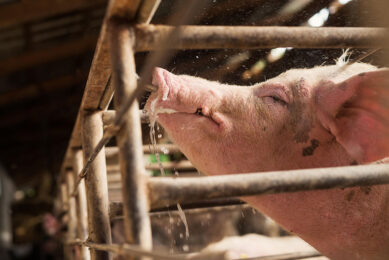Heat stress series:Management tips to reduce heat stress

In this series, every author looks at the problem of ‘heat stress’ from a different angle. In Pig Progress, issue 33.07, veterinarian Steve McOrist considered a veterinarian approach to the issue. In this article, it is time for a management approach. How can heat stress be alleviated with modern techniques inside the barn?
At elevated temperatures, animal performance is usually degraded. Common effects of high temperatures are a decrease of appetite, feed efficiency and weight gain – and this applies to all kinds of pigs in all phases – boars, sows, piglets or grow-finisher pigs.
In all this, sows are of particular concern in warm circumstances, because heat stress reduces their capacity to produce milk, and will decrease the growth of piglets after birth. During lactation, the effects can worsen in the form of a more substantial weight loss, with possible repercussions on the reproductive cycle following.
In short, high temperatures are disadvantageous for pig production efficiency. In many studies it has been demonstrated that swine performance is compromised when they are raised in hot, and especially tropical, conditions.
How to fight against heat?
Solutions have emerged recently, notably for sows during lactation. The techniques commonly used for animals are based on several principles. This includes e.g. the evaporation of water and the chilling effect of air.
1. A cooling system
Evaporative cooling happens when liquid water changes into a gaseous form. There are various ways to achieve that. Either the incoming air is moistened passively (a process known as pad cooling) or the air is charged with moisture via an injection under pressure (high or low pressure misting). A high-pressure system (at 150 bar) is more efficient than low pressure equipment (at 3 to 5 bar), but a high-pressure system requires a more frequent maintenance.
The biggest advantage of these systems is that they cool directly into the room and do not modify the performance of the ventilation system.
Figure 1 – Cooling pad: a schematic diagram.

Care must be taken not to increase the relative humidity in the rooms, because elevating the relative humidity obstructs the effects of the cooling process for pigs. As the cooling acts only on the incoming air, however, the increase of the humidity is low. There is also a risk that the new air is already warm before it reaches the animals. In addition, cooling can break the speed of incoming air. The air speed on the air entry must be between 1 to 2 m/s to have a good efficiency on the system.
These cooling systems have the advantage of being able to be applied to all stages of production. That includes maternity, because they cool the atmosphere without causing an airflow right at the piglets.
In general one can say that cooling systems are the most efficient when the relative humidity outside is lower than 85%. As soon as the relative humidity starts exceeding 80%, a cooling system must be accompanied by an increase in air speed in buildings, except in the maternity rooms.
Figure 2 – Decreased temperature by the pig according tothe pig speed.

2. Drip cooling for sows
For sows in lactation, there is an alternative which does not cool the air but rather cools down the animal: drip cooling. Its beneficial effects were measured by the University of Kansas, USA, over 15 years ago. Drip cooling is achieved by placing a dripper above the sows’ necks and shoulders. The device proceeds in short sequences of operation of one drop every ten seconds.
Drip cooling was used during trials at the tropical island Réunion, in the Indian Ocean. When applying drip cooling, the sows’ daily consumption increased over 9kg at a room temperature of 27°C. Piglet losses decreased by 50% during lactation, from 14 to 7%; this happened especially because crushing occurred less frequently.
3. Air blowers
Air blowers create a permanent flow of air around the pigs, creating a cooling effect. It has been established that, when air moves faster than 0.2 m/s, each additional 0.1 m/s higher velocity creates a cooling effect of 1°C (also see Figure 2). For example, at an air speed of 0.5 m/s inside the pig house, 30°C will feel like 27°C.
This technique has the advantage of not being dependent on air humidity. It is, however, limited to buildings having sufficient volume. In addition, blowing air should not be used in maternity houses, because excessively high air speeds will cool piglets, causing diarrhoea and lowering growth.
Figure 3 – Circulation fans location and orientation in pens.

4. The pig’s own thermostat
The 3 approaches mentioned above speak of methods of how to change the air surrounding the animals. The animals themselves, however, also have a role to play in this respect and it is vital to understand how pigs lose or gain heat in this context. Basically, heat energy is constantly being transferred between the pig and its surroundings. This happens in four different ways – conduction, convection, radiation and evaporation. The first three are grouped into what is called ‘sensible heats’, implying that a temperature difference is required to exchange heat.
This article is a second in a heat stress series, which has been made in cooperation with Animine.
 Beheer
Beheer








 WP Admin
WP Admin  Bewerk bericht
Bewerk bericht